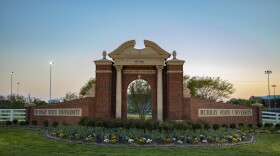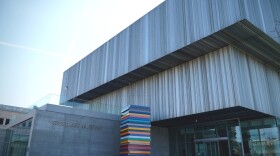Jefferson County Public Schools’ new transportation plan failed on the first day of school, causing the district to cancel classes for six days. Bus drivers told us it failed because their assigned routes are impossible.
We got data that showed where and when buses were supposed to arrive. Then we picked a random bus route and spent a day trying to hit all the stops and schools the driver is expected to arrive at on time.
The morning route
The route we picked services four different schools every morning: Butler Traditional High School, Lassiter Middle School, Doss High School and Medora Elementary. All in all, the bus has about 50 stops to hit, including the schools.
Our first stop required us to arrive at an intersection near the southeastern edge of Jefferson County at 5:44 a.m.
The roads were foggy and, like a JCPS bus driver, we only had paper directions to guide our way. We hoped to get there a little early, but arrived exactly at 5:44 a.m.
We stopped at each location for 33 seconds. JCPS told us they estimate each stop would take a baseline 30 seconds, plus three seconds for each student getting on or off the bus.
Soon after the first stop, we found that some of the directions we printed off from Google Maps were either confusing or incorrect. While we’re not sure what directions drivers used, we heard they too had inaccuracies in their directions. The unfamiliar residential roads were hard to navigate, especially when street signs were missing or illegible. Still, we made wrong turns or overshot stops on just a handful of occasions.
Unlike the bus, we had the benefit of driving a small vehicle that could easily make U-turns. Still, each wrong turn put us a minute or two behind we couldn’t afford – there were no chances for breaks, and mistakes compounded.
Although we got our imaginary students to Butler Traditional about 20 minutes ahead of the starting time, all of our other “students” arrived late. By our last stop of the morning at Medora Elementary, in far southwestern Jefferson County, our imaginary kids arrived 20 minutes after the 9:40 a.m. start of school. Overall, we were 30 minutes behind schedule.
We noticed how stressed and exhausted we were after the morning shift — which required five hours of non-stop driving, even without students.
Bus drivers get a break of about four hours between the morning shift and afternoon shift. We went back to our respective homes and tried to relax, hoping the afternoon would be a chance to put the errors of the morning behind us.
The afternoon shift
The afternoon route required 60 stops as we simulated busing kids from Central High School, Farnsley Middle School, Western High School and Johnsontown Road Elementary.
This time, we decided to follow the bus driver who was practicing her route. We thought we might benefit from her previous days of practice and make fewer wrong turns.
A fleet of about two dozen buses left Central High school at 2:27 p.m., seven minutes after school would have been dismissed. Our first stop was scheduled for 2:31 p.m. — 20 blocks away at the corner of 32nd and Broadway.
It was not possible to get to our first stop on time. Driving down Broadway in the afternoon, we hit multiple stop lights and mild traffic and arrived four minutes late at 2:35 p.m. Like the morning, the lateness compounded with no wiggle room for error.
Following a driver, we also quickly noticed that she had found a better order for the stops than the JCPS route we had obtained. The driver’s route seemed to create better opportunities to turn around, or to make sure students wouldn’t have to cross busy, four-lane streets on foot. The variation sometimes meant students were dropped off 15 to 20 minutes ahead or behind schedule.
We also noticed the driver wasn’t stopping anywhere near 33 seconds like we tried in the morning. (We don’t know if they were instructed to or not.) Without students, the bus driver usually paused only about 5 to 10 seconds at each stop and then continued.
As traffic picked up closer to rush hour, small delays added up. At one point a USPS truck that was stopped in the street forced the bus to go out of its way. It wasn’t a significant deviation from the route, but those delays compounded. On multiple occasions, the bus we followed had to wait several minutes at intersections to safely turn left across a steady stream of typical rush-hour traffic.
By the time we arrived at our last school, Johnstown Road Elementary, our imaginary students would have been waiting roughly an hour after the final bell for us to arrive and pick them up.
We finished our last imaginary dropoff at about 6:30 p.m., although the schedule said we should’ve arrived at 5:41 p.m. The bus we followed was more than 45 minutes behind schedule.
We briefly talked to the bus driver we followed before she headed back to the compound. She said she was glad we had followed her and, although she didn’t want to be identified, said the day’s challenges were typical.
After nine hours on the road, we came to the conclusion that many of the routes were impossible to complete in the time allotted. Following a sheet of printed directions without GPS added considerable stress. Without any major problems, without having to navigate a 30-foot bus and without any student interaction, we were still repeatedly late and felt like any small variable would create significant delays.
Support for this story was provided in part by the Jewish Heritage Fund.







